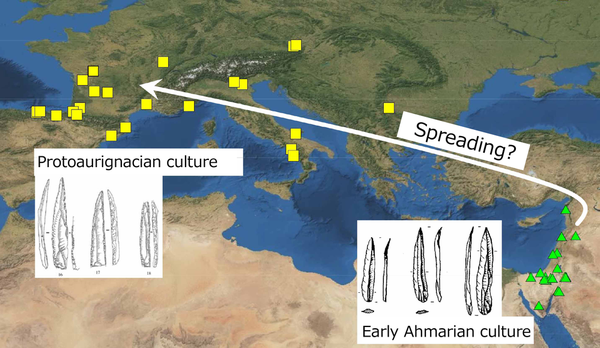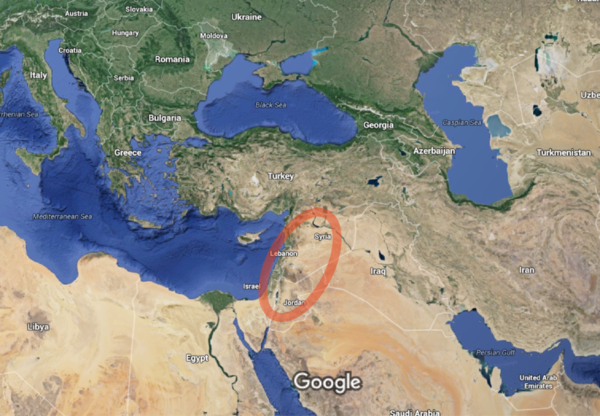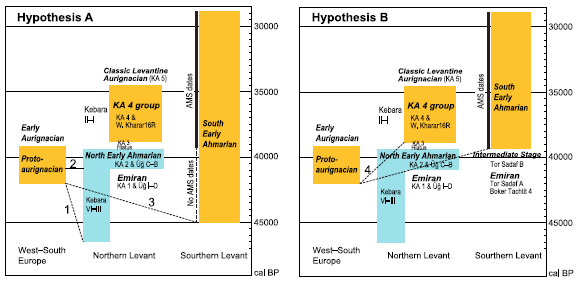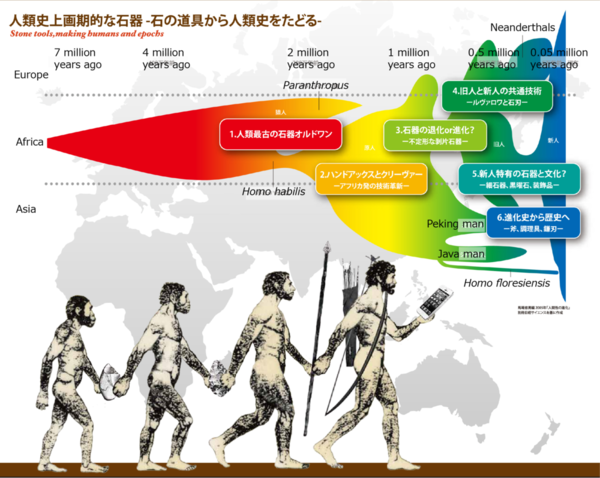Highlights
Highlights
Updating human evolution through examination of technological innovation in stone tools
- Read in Japanese
- ツイート
- 2015/09/14
- Nagoya University Museum
- Graduate School of Environmental Studies
- Assistant Prof. Seiji Kadowaki
Assistant Prof. Seiji Kadowaki, Nagoya University Museum and Graduate School of Environmental Studies at Nagoya University, and his research group at the University Museum at the University of Tokyo reported a new hypothesis on the cultural adaptation of Homo sapiens during the late Pleistocene and its implications on the demise of Neanderthals, one of archaic human groups that lived in Eurasia at that time.
The researchers suggested that one of te significant technological innovations, as observed in stone tools, was a result of the successful colonization of Europe by Homo sapiens. This observation is congruent with recent chronological and genetic studies indicating the co-existence of Homo sapiens and Neanderthals between ca. 45,000 and 40,000 years ago in Europe.
This study was published on April 25, 2015, in the Journal of Human Evolution by Elsevier Ltd. → Nagoya Universtiy Press Release
Human evolutionary history was re-examined through the researchers’ keen observation of stone tools and through highly precise radiocarbon dating.
Assistant Prof. Seiji Kadowaki, Nagoya University Museum and Graduate School of Environmental Studies at Nagoya University, and his research group examined one of current models on the technological development in hunting tools: specifically, projectile weapons.
Used as tips for the projectile weapons (e.g., darts or arrows), small stone points were invented early on by Homo sapiens groups in Africa and West Asia (Middle East). Then, some of the Homo sapiens groups with this innovative technology moved to Europe about 42,000 years ago: this has been considered one of important causes for the demise of Neanderthals.
A main body of chronological data of this time period has been provided by the rate of radioactive disintegration of radiocarbon (14C). That is, to measure the time that elapsed after the death of living creatures, the time estimation is determined based on the relative amount of 14C contained in organic remains (e.g., plants and bones).
According to the radiocarbon dating results so far, the model above has been suggested since small stone points appeared earlier in West Asia than in Europe.
However, the accuracy and precision of radiocarbon dates vary depending on pretreatment and measurement methods, which have been improving since the 1950s. This is problematic because all the radiocarbon dates determined by the various methods should not equally be compared.
“It is necessary to re-examine archaeological records that have been studied in the past as dating technology improves.”
Assistant Prof. Kadowaki has examined the variability of stone tool technology related to the production of small points in West Asia and then discussed their temporal distributions by considering the reliability of radiocarbon dates. This led him to propose a new hypothesis on the human evolution.
*******
As a general background of human evolution, Figure 1 shows a 7-million-year-history of human evolution.
Figure 1. A 7-million-year-history of human evolution (Figure : by courtesy of Assistant Prof. Kadowaki)
About 7 million years ago in Africa, human ancestors took an evolutionary path different from that of chimpanzees. These early hominin groups are named as, for example, Ardipithecus and Australopithecus. About 2.5 million years ago, two different genus groups—Paranthropus and Homo—appeared. While Paranthropus groups went extinct, some of the Homo groups survived and left Africa, spreading to Eurasia. One of the footsteps in this “Out-of-Africa” journey has been found at a 1.8 million-year-old site at Dmanisi in Georgia. Other Homo groups spread to East Eurasia, as we know them as popular names of Java man and Peking man. Subsequently, these early Homo groups evolved to Homo sapiens at various areas in Eurasia and Africa. This led to the emergence of Neanderthals in Europe, as some of Homo sapiens spread out of Africa into Europe where archaic human groups, like Neanderthals, were still living.
—This scenario of human evolution means that archaic humans, such as Neanderthals, were widespread in Eurasia when Homo sapiens emerged in Africa. However, archaic humans went extinct subsequently, while Homo sapiens groups spread to Eurasia and eventually became an only human species, becoming our direct ancestors.
“I specialize in prehistoric archaeology, which is a study of past human behavior, culture, lifeways, and also ways of thinking if possible, from archaeological records. We deal with time periods before the invention of letters.”
Assistant Prof. Kadowaki has been studying when and where cultural and technological innovations occurred during the geographic expansion of Homo sapiens, out of Africa. For this study, he uses archaeological records, particularly stone tools that can be well preserved over tens of thousands of years.
On the basis of temporal and spatial variability of stone tool technology, Assistant Prof. Kadowaki re-examined one of the popular models on Homo sapiens out of Africa.
According to the model, the spread of Homo sapiens into Europe was associated with a unique stone tool technology that produces small points, which can be used as a tip of projectile weapons (Figure 2). This technology is considered to have emerged in West Asia (particularly in the Levant) as an archaeological record known as the Early Ahmarian culture. This culture was then brought to Europe by Homo sapiens around 42,000 years ago, resulting in the appearance of similar small point technology (known as Protoaurignacian culture) in Europe.
 Figure 2. According to the existing model, Early Ahmarian's stone tool technology was brought to Europe. (Figure : by courtesy of Assistant Prof. Kadowaki)
Figure 2. According to the existing model, Early Ahmarian's stone tool technology was brought to Europe. (Figure : by courtesy of Assistant Prof. Kadowaki)
This implies that innovative technology created by Homo sapiens in West Asia augmented their adaptability and assisted their colonization of Europe, causing the eventual demise of Neanderthals.
Assistant Prof. Kadowaki and his co-researchers, however, argued that stone tool technology of the Early Ahmarian culture had actually been too diverse to be regarded as the same as the Protoaurignacian in Europe.
 Figure 3. The Levant area, the East coast of Mediterranean sea (in a red circle)
Figure 3. The Levant area, the East coast of Mediterranean sea (in a red circle)
To collect data, Assistant Prof. Kadowaki and his research colleagues conducted fieldwork in the Levant area between 2008 and 2011 (Figure 3) and investigated an archaeological site, Wadi Kharar 16R (Figure 4), located in the middle Euphrates region, inland Syria.
 Figure 4. The archaeological site, Wadi Kharar 16R and its panoramic view, located in the middle Euphrates region, inland Syria. (Figure:Kadowaki, et al. Journal of Human Revolution (2015) 82: 67-87. Copyright © 2015, Rights Managed by Elsevier. Picture : by courtesy of Assistant Prof. Kadowaki)
Figure 4. The archaeological site, Wadi Kharar 16R and its panoramic view, located in the middle Euphrates region, inland Syria. (Figure:Kadowaki, et al. Journal of Human Revolution (2015) 82: 67-87. Copyright © 2015, Rights Managed by Elsevier. Picture : by courtesy of Assistant Prof. Kadowaki)
The researchers collected more than 1,000 samples of stone tools, including small points (Figure 5), indicative of the Early Ahmarian culture. They also obtained radiocarbon date (ca. 38,000–37,000 years ago) from Wadi Kharar 16R.
Figure 5. Collected stones in this study and their skeched images. Determined by the ripples, the arrows in the images show the hit spot when making stone tools. (Pictures: by courtesy of Assistant Prof. Kadowaki. Figure:Kadowaki, et al. Journal of Human Revolution (2015) 82: 67-87. Copyright © 2015, Rights Managed by Elsevier)
Additionally, they examined radiocarbon dates previously reported for the Early Ahmarian culture (68 samples) and the Protoaurignacian culture (58 samples), particularly paying attention to the details in methodology. As a result, they suggested that reliable dates for the Early Ahmarian are in the range of 39,000–34,000 years ago, while those for the Protoaurignacian are 42,000–39,000 years ago. This means that the Protoaurignacian is like to have appeared earlier than the Early Ahmarian on the contrary to the existing model (Figure 6).
 Figure 6. Hypothesis A is the existing model, while B is the newly proposed model: the Early Ahmarian culture in the South Levant area appeared earlier than the Protoaurignacian culture in Europe. (Figure:Kadowaki, et al. Journal of Human Revolution (2015) 82: 67-87. Copyright © 2015, Rights Managed by Elsevier)
Figure 6. Hypothesis A is the existing model, while B is the newly proposed model: the Early Ahmarian culture in the South Levant area appeared earlier than the Protoaurignacian culture in Europe. (Figure:Kadowaki, et al. Journal of Human Revolution (2015) 82: 67-87. Copyright © 2015, Rights Managed by Elsevier)
“We are proposing that the current model of the cultural spread from the Levant to Europe about 42,000 years ago needs to be re-considered.”
If the Protoaurignacian culture did not have its roots in the Levant, ―what is its origin? Assistant Prof. Kadowaki and his colleagues noted the possibility that the Protoaurignacian culture was invented in Europe by Homo sapiens group that had already spread there.
In fact, there are increasing records that suggest the existence of Homo sapiens in Europe before the Protoaurignacian. For example, teeth remains from Grotta del Cavallo, Italy (45,000–43,000 years ago) have been identified as Homo sapiens, and the Early Aurignacian culture found at Willendorf II in Austria (43,500 years ago) is generally considered as a product by Homo sapiens.
The new hypothesis implies that cultural or technological innovations by Homo sapiens occurred often after their geographic expansion, possibly prompted by new natural and social environments.
*******
“What caused the different histories between Homo sapiens and Neanderthals? Homo sapiens eventually grew in population, while Neanderthals went extinct as groups.”
This is the big question shared by many palaeoanthropologists and archaeologists like Assistant Prof. Kadowaki.
The more we consider this question, the more the mystery thickens. However, it could become clearer with the concrete steps in the advance of research including archaeological records and radiocarbon dating. It is interesting that experts in various fields, such as genetics and earth sciences, are interacting and challenging together for the beliefs in human history.
By the way, recent genetic studies propose that we Homo sapiens have inherited around 2% of our DNA from Neanderthals, indicating inter-breeding between the two types of humans.
— Succinctly and aptly remarked by Elvis Presley, “Everybody comes from the same source. If you hate another human being, you’re hating part of yourself.”
(Ayako Umemura)
Researcher featured in this article
Dr. Seiji Kadowaki【Assistant Professor, Nagoya University Museum/Graduate School of Environmental Studies, Nagoya University】
 Dr. Kadowaki graduated from the Department of History and Culture, Faculty of Letters, the University of Tokyo in 1997. After completing his master’s course at the Graduate School of Humanities and Sociology at the University of Tokyo in 1999, he studied at the Department of Anthropology at the University of Tulsa, U.S.A., and obtained M.A. in 2002. In 2007, he received his doctoral degree from the Department of Anthropology, University of Toronto, Canada. Between 2007 and 2008, Dr. Kadowaki worked as a postdoctoral researcher at the Social Sciences and Humanities Research Council of Canada. Then, he carried on his research, obtaining a research fellowship for young scientists (SPD) in 2008–2009. He moved to the University Museum at the University of Tokyo as an assistant professor between 2009 and 2010. He has been working in the current position since 2010.
Dr. Kadowaki graduated from the Department of History and Culture, Faculty of Letters, the University of Tokyo in 1997. After completing his master’s course at the Graduate School of Humanities and Sociology at the University of Tokyo in 1999, he studied at the Department of Anthropology at the University of Tulsa, U.S.A., and obtained M.A. in 2002. In 2007, he received his doctoral degree from the Department of Anthropology, University of Toronto, Canada. Between 2007 and 2008, Dr. Kadowaki worked as a postdoctoral researcher at the Social Sciences and Humanities Research Council of Canada. Then, he carried on his research, obtaining a research fellowship for young scientists (SPD) in 2008–2009. He moved to the University Museum at the University of Tokyo as an assistant professor between 2009 and 2010. He has been working in the current position since 2010.
***
 “Nothing can replace such a pleasant feeling as that of new discovery,” Dr. Kadowaki stated enthusiastically. Once a year, for a month, he goes to field-work in the Middle East.
“Nothing can replace such a pleasant feeling as that of new discovery,” Dr. Kadowaki stated enthusiastically. Once a year, for a month, he goes to field-work in the Middle East.
During the interview, Dr. Kadowaki kindly demonstrated how to make stone tools and I also tried to make one for the first time. I found this to involve physics, as a stone can be shaped by hitting the right spot. It is fascinating to ponder how it was developed tens of thousands years ago. Dr. Kadowaki’s further achievements are expected to provide deeper understanding of the mystery in human evolution (by AU)
Links
- Seiji Kadowaki Lab HP http://www.num.nagoya-u.ac.jp/outline/staff/kadowaki/laboratory/index.html
- Nagoya University Museum HP http://www.num.nagoya-u.ac.jp/english/
- Graduate School of Environmental Studies, Nagoya University, HP http://www.env.nagoya-u.ac.jp/english/index.html
- Department of Earth and Planetary Sciences, Nagoya University, HP http://www.eps.nagoya-u.ac.jp/en/index_en.html
- Link to this article (from a search-result)
http://www.sciencedirect.com/science/article/pii/S0047248415000500
Seiji Kadowaki, Takayuki Omori, and Yoshihiro Nishiaki
Variability in Early Ahmarian lithic technology and its implications for the model of a Levantine origin of the Protoaurignacian.
Journal of Human Evolution 82: 67-87 (2015).
(First published on April 25, 2015; doi: 10.1016/j.jhevol.2015.02.017)
NU Research
(English)



